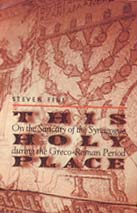This Holy Place: On the Sanctity of the Synagogue During the Greco-Roman Period
Steven Fine (Notre Dame: Univ. of Notre Dame Press, 1997) 280 pp., $35.00 (hardback) $24.00 (paperback)

At some point during the first millennium, the synagogue was transformed from a place to meet one’s fellows into a house of meeting with God. Between the first and seventh century C.E., the synagogue’s scroll chest (teva) became an ark (aron), and the sacred laws of sanctity governing the Temple were increasingly applied to the synagogue.
What was the driving force behind this gradual “templization”—as Steven Fine puts it—of the synagogue? How did a multipurpose community center become a sacred space?
In This Holy Place, Fine, professor of rabbinic literature and history at Baltimore Hebrew University, traces this shift with unprecedented nuance and detail. As he notes, the Torah scrolls that were read, studied and stored in synagogues were the wellspring of synagogue sanctity. Moreover, with an ever-increasing chronological gap separating the Jews from God’s house, Temple motifs gained prominence as the synagogue and its liturgy evolved—most likely following the Roman destruction of the Jerusalem Temple in 70 C.E.
Already a library member? Log in here.
Institution user? Log in with your IP address.

